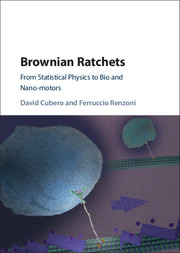Book contents
- Frontmatter
- Dedication
- Contents
- Preface
- Part I Historical overview and early developments
- 1 Limitations imposed by the second law of thermodynamics
- 2 Fundamental models of ratchet devices
- 3 General relevance of the concept of ratchets
- Part II Theoretical foundations
- Part III Experimental realizations of ratchet devices
- Appendix A Stochastic processes techniques
- Appendix B Symmetries in a 1D overdamped system
- Appendix C Floquet theory
- Index
3 - General relevance of the concept of ratchets
from Part I - Historical overview and early developments
Published online by Cambridge University Press: 05 January 2016
- Frontmatter
- Dedication
- Contents
- Preface
- Part I Historical overview and early developments
- 1 Limitations imposed by the second law of thermodynamics
- 2 Fundamental models of ratchet devices
- 3 General relevance of the concept of ratchets
- Part II Theoretical foundations
- Part III Experimental realizations of ratchet devices
- Appendix A Stochastic processes techniques
- Appendix B Symmetries in a 1D overdamped system
- Appendix C Floquet theory
- Index
Summary
The early theoretical work on ratchets was motivated by the desire to reach a deeper understanding of the foundations of statistical thermodynamics and explore the role that noise may play in nonlinear systems. Nowadays, ratchets have an established place in any discussion regarding the second law of thermodynamics, and many years after its introduction, the Brillouin paradox is still an ideal framework to highlight many subtleties in the treatment of stochastic processes in nonlinear systems. A new aspect in the research related to ratchets emerged in the early 1990s, when it became clear that the concept of ratchets may offer a key for the understanding of molecular processes at the nanoscale. It is precisely in this context that the flashing ratchet and the rocking ratchet were introduced, and it should now come with no surprise that the authors were researchers in the field of biophysics. The mechanisms behind the operation of these ratchets were described in the previous chapter. This chapter examines how these mechanisms can be related to the operation of molecular motors. It will also examine the relevance of the concept of ratchets to the field of game theory, and indeed the flashing ratchet finds an elegant description in terms of a paradoxical game, where two losing games surprisingly combine to produce a winning game.
The realm of the world at the nanoscale
The concept of ratchets is very relevant for systems at the nanoscale, as processes at this scale are significantly affected by the presence of noise. The story of how the relevance of the realm at the nanoscale was brought to attention is a fascinating one.
In 1959, Feynman gave a famous lecture at the annual meeting of the American Physical Society titled “There's plenty of room at the bottom”, encouraging scientists and engineers to start creating devices with sizes in the order of nanometers. Though nanotechnology only really started a while later, in the late 1980s, Feynman's talk is usually credited as the beginning of this vigorous focus on the nanoscale, which is still currently being actively pursued. In his lecture, Feynman did not hide his main source of inspiration for such a groundbreaking proposal, the molecular motors of biological systems, which already perform all kind of wonders at this small scale.
- Type
- Chapter
- Information
- Brownian RatchetsFrom Statistical Physics to Bio and Nano-motors, pp. 27 - 36Publisher: Cambridge University PressPrint publication year: 2016

